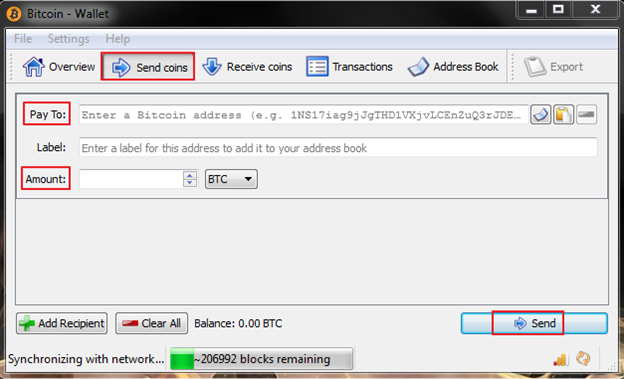How to Send and Receive Cryptocurrency

How to Transfer Cryptocurrency From one Wallet to Another (i.e. how to Send/Receive or Withdraw/Deposit Bitcoin, Ethereum, and Other Cryptos)
To send or receive cryptocurrency, first you need a cryptocurrency wallet, then you need to put in the public address of the recipient to send (or give your public address and have someone else put it in to receive).
Often this can be as easy as scanning the QR code related to the receiving address and typing in the amount you want to send, but in cases where you don’t have a QR code then copy and pasting the public address is the next best bet.
From there you just choose the amount you want to send, follow any other wallet-specific instructions (for example adding funds for fees if necessary), and then hit send (or your wallet’s equivalent).

Once that is done the transaction just needs to settle on the blockchain (how long that takes can differ between blockchains and depend on how much you paid in fees).
If you are anxious, you can always check the status of the transaction on the blockchain by using the block explorer of the coin you sent.
Below I’ll walk through the process in a bit more detail to make sure you fully understand each step.
TIP: The above process is sued to send/receive crypto, withdraw/deposit crypto, and buy things with crypto… it is how crypto transactions work regardless of what their purpose is 😉
Sending and Receiving Cryptocurrencies
This process of sending and receiving cryptocurrencies like Bitcoin, Litecoin, Ether, etc. can differ slightly between wallets (as each coin has its own set of wallet options in which that cryptocurrency can be stored), but in general:
- Log into a wallet you have funds in.
- Go to the send/receive screen (by clicking the tab or button that says this or shows the proper icon).
- Choose whether you want to send or receive cryptocurrency. TIP: In general you must only send and receive like-coins. Meaning, you can only send/receive Bitcoin-to-Bitcoin, Litecoin-to-Litecoin, etc. (you can’t, for example, send Bitcoin to an Ethereum wallet or even Bitcoin to a Bitcoin Cash wallet).
- For sending: Enter the public wallet address of the recipient and choose the amount to send (make sure to account for transaction fees; you’ll need enough coins in your wallet to pay the fee). After you confirm the numbers, triple-checking them to avoid silly mistakes then hit “send transaction” (or the equivalent) and verify the transaction one last time (confirming your public address and their public address is correct). TIP: you can write a note with your transaction to let the recipient know what transaction is for. TIP: Using a QR code to copy an address helps avoid potential mistakes.
- For receiving: You don’t have to do anything except share your public wallet address with the sender. If you are in person, you can do this by letting them scan a QR code (if your wallet offers that).
If you are still uncertain, just look up the FAQ for the wallet you are using to verify you have the steps down. Check out the video below for more.
Tips and Tricks For Crypto Transactions
Below are some more tips and tricks for crypto transactions.
Send a test amount to new addresses: Before you send a lot of crypto, try sending a little bit as a test to make sure everything is working.
Using exchanges to send coins: For sending between exchanges you’ll want to use the withdraw and deposit buttons on the exchange next to the token you want to send. You must follow directions carefully, as sometimes you’ll need to follow specific directions. For example you might need to include a message, and sometimes you can only send whole numbers of coins. You may also need to use your authentication codes.
TIP: A wallet’s public address (or “public key”) looks like this: BTC Wallet: 1Bn9PjWsFwfwLLEbhagQE9ksUSBcT2jLTm, ETH Wallet: 0xf902fd8B2AEE76AE81bBA106d667cCF368C2f9A1, LTC Wallet:LdRi8Md4bU8iCv3gkHv4NfvMoitV3AXF6u… Private keys look different. You should never share your private key, but as you can tell from our share above, sharing your public wallet address is not a problem. So again, do share the public address that looks like that (the worst that can happen is someone puts coins in it), but never share your private key or password (as that is like handing a stranger your wallet).
Crypto-to-crypto exchange: You can use a platform like Shapeshift to turn one type of cryptocurrency into another. That can be helpful if you have Bitcoin, but want to do a transaction in another coin.
Why didn’t my transaction go through? After you have sent some coins (AKA tokens AKA cryptocurrency), you’ll need to allow some time for the transaction to go through. It can be nearly instant, or it could take a few minutes, or if traffic is high, it could take hours. In most wallets, you can view pending transactions. Remember, the transaction will be added to the coin’s public blockchain (a digital ledger of transactions), so you’ll always be able to see an encrypted version of it. See Etherescan.io for an example of a website that let’s you view every public action on a blockchain.
